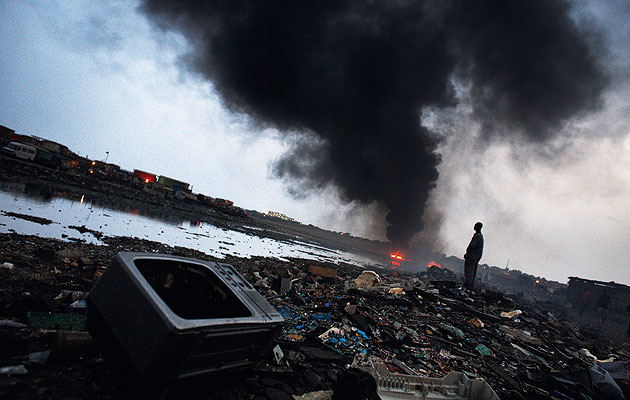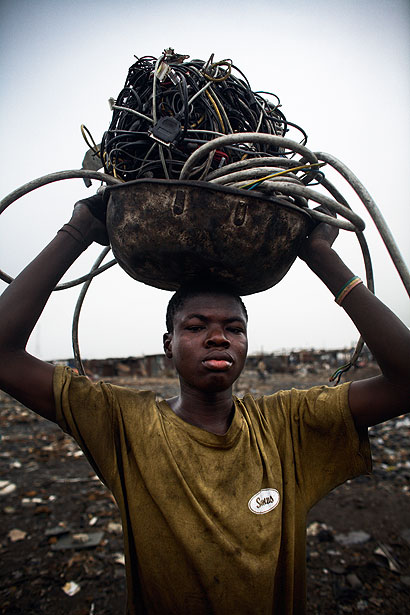|
Cables are burned to strip off their plastic coating, shrouding the site in smoke and poisoning the soil (image: Andrew McConnell/Panos Pictures) |
||
|
Agbogbloshie is a 21st-century hell. This site, a vast clearing in the Ghanaian capital Accra, is where computers and household electronics go to die. It’s a public health emergency in Ghana and an embarrassment to the West. Electronics are chock-full of hazardous materials and not enough is done to design them with the end of their life in mind. This is something environmental charity Greenpeace hopes to change by focusing attention on Agbogbloshie and the other “e-waste” sites like it elsewhere in Ghana and in Nigeria. The site isn’t just a dump – it’s partly a market and ad hoc recycling centre. E-waste arrives by the truckload from the nearby docks. “You have little workshops there, mostly just poles with a roof, where people dismantle the waste, often with no more equipment than a stone,” says Kim Schoppink, toxics campaigner for Greenpeace Netherlands. Some useful materials and components are stripped out and sold on to brokers. Meanwhile, cables are burned in open fires to remove their PVC coating and get to the valuable copper inside. “This whole area is often covered in the smoke from those fires, so you’re breathing in the smoke the whole time,” Schoppink says. Much of this burning is done by children. It’s hardly a surprise that Agbogbloshie is very polluted – Schoppink’s soil samples revealed a cocktail of toxic compounds, including lead, mercury, cadmium and dioxins. Shockingly, much of the waste that ends up in Agbogbloshie and dumps like it has been disposed of “responsibly”. Companies wanting to get rid of old computers ethically give them to brokers, believing that they are being sent to Africa to be re-used, but in fact they are mostly just dumped. Even more surprisingly, some of the waste comes from council-run recycling centres in the UK and Western Europe – the very places consumers are urged to take their defunct electronics. “Often those at municipal collection points sell [the waste] to illegal brokers as well, and from there it goes to Ghana and Nigeria,” says Schoppink. “Last year we took a TV with a tracking device in it to a municipal collection point in the UK and it ended up in Nigeria.” With even consumers and councils finding it hard to behave ethically, Greenpeace is targeting its campaign against e-waste dumping at designers. “Designers should start making electronics that are free of toxic chemicals, so recycling is not hazardous, and should make electronics that are easier to dismantle with purer materials that can be re-used for new electronics,” Schoppink says. www.greenpeace.org
Much of the work on the Agbogbloshie site is done by children (image: Andrew McConnell/Panos Pictures) |
Words William Wiles |
|
|
||





















